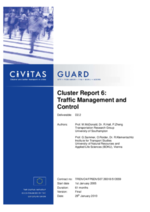Implementing a bus priority scheme
Thematic areas
Smart, Sustainable, Connected and Shared mobility
Summary
Bus priority systems were tested on a small scale in Toulouse, with the aim of full integrating them at operational level throughout the city.
Implementing sustainable mobility
Toulouse has a large geographical residential area and is characterised by significant demographic growth. At the time of measure implementation, the public transport network included 56 urban bus lanes, two underground lines and urban railway lines to two neighbouring towns. Toulouse aimed to improve service quality and achieve a modal shift towards public transport, from the existing 7 percent share. Bus priority systems can be considered as one of the most effective solutions for improving the quality of bus network services: studies undertaken in France showed that bus priority systems can save between 20 and 30 percent of journey time at junctions.
The aim was therefore to develop a bus priority system at the level of the urban area, to adapt the existing traffic control system to integrate bus priority information, and to test a radio priority system.
Progress
The creation of a centralised control system at bus network scale and its integration into the existing road traffic control system requires sophisticated tools, which proved too time-consuming to develop within the MOBILIS project. The centralised approach was therefore postponed.
Instead, the measure focused on developing and implementing two bus priority systems. Two bus lines were equipped with a priority request system in order to assess the advantages and constraints of the system for both public transport and private car flows.
In the first trial, a radio call priority system was used, which functions via an onboard command box that communicates codes to the traffic light controller.
The second trial focused on buses in the high-quality corridors, which were equipped with beams that activate electromagnetic loops to obtain priority at traffic lights.
Outcomes
The radio call priority system functioned well, with 96.4 percent of priority requests satisfied. Bus regularity and journey times improved and average bus waiting times at traffic lights was reduced by 52 percent (9 seconds). Although drivers appreciated the ease of the tested system, its efficiency depended on the bus direction and approach lane layout.
In the second trial, the different bus lanes leaving and joining the corridor at the tested junction introduced many difficulties in defining the traffic light cycle algorithm. In particular, the installation of a bus stop just before the traffic light lane disrupted the priority request efficiency. At a second tested junction, priority requests were 89 percent satisfied in one direction only. In the other direction, rates varied between 32 and 55 percent. Private vehicle flow fell by 6 percent on the roads opposite the bus priority. Traffic modelling at the two junctions showed that an increase of 50 to 100 percent in priority request–equipped vehicles would require a complete overhaul of the algorithm to prevent traffic congestion.
On the basis of the trials, the city of Toulouse decided to equip new junctions with bus priority systems. The measure highlighted the importance of integrating the constraints of the junction surroundings into the development of the priority system tools.








